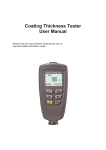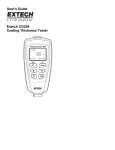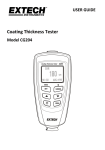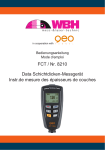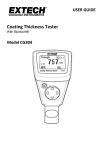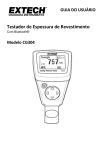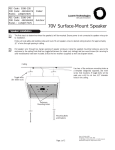Download Operating Instructions - York Survey Supply Centre
Transcript
Nothing else measures up! Prospect House George Cayley Drive Clifton Moor York England YO30 4XE Tel: +44 (0) 1904 692723 Fax: +44 (0) 1904 690385 E-Mail: [email protected] ...for secure online ordering of all our products! Ref:.. \operat98\instructions 15\346010.qxp 05-01-15 Compact Coating Thickness Meter Code: 346010 Operating Instructions ©York Survey Supply Centre 2015 Compact Coating Thickness Meter occasional measurements. It provides statistical analysis. Single values are not saved. The statistical analysis program can evaluate 80 readings. • GROUP mode permits measurement and storage of readings in a free programmable memory. A maximum of 400 readings and 4 series of measurements can be analyzed according to various statistical criteria. 1. General Information The DT-156 coating thickness gauges work either on the magnetic induction principle or on the eddy current principle, depending on the type of probe used. You can select the type of probe via MENU system, or it will work automatically. The gauges conform to the following industrial standards: GB/T 4956-1985 GB/T 4957-1985 JB/T 8393-1996 JJG 889-95 JJG 818-93 1.3 Supply Schedule • Gauge with two 1.5V batteries, plastic carrying case, operating instructions, steel and aluminium substrate. • USB connecting cable • Program disc for Windows 98/2000/xp/Vista/7 1.4 Probe The probe systems are spring-mounted in the probe sleeve. This ensures safe and stable positioning of the probe and constant contact pressure. A V-groove in the sleeve of the probe facilitates reliable readings on small cylindrical parts. The hemispherical tip of the probe is made of hard and durable material. Hold the probe by the spring-mounted sleeve and put on measuring object. Features • Measured Coatings: Non-magnetic coatings (e.g. paint, zinc) on steel; insulating coatings (e.g. paint, anodizing coatings) on non-ferrous metals • Operating with MENU easily • Two measuring modes: CONTINUE and SINGLE mode • Two working modes: DIRECT and GROUP mode (4 groups) • Statistic Display: AVG, MAX, MIN, NO., S.DEV • One point calibrating and two points calibrating independently for each working mode • Zero calibrating easily • Memory for 320 readings (80 for each group) • Delete single readings and all group readings easily • High alarm and Low alarm for all working modes • Low battery, error indication • USB interface for PC analysis software • Disable Auto-Power-Off function via MENU setting 1.5 Specifications Ref:.. \operat98\instructions 15\346010.qxp 05-01-15 F N Measuring range 0~1250µm 0~49.21mils 0~1250µm 0~49.21mils Working principle Guaranteed tolerance (of reading) 1.1 Application • This compact and handy gauge is designed for non-destructive, fast and precise coating thickness measurement. The principal applications lie in the field of corrosion protection. It is ideal for manufacturers and their customers, for offices and specialist advisors, for paint shops and electroplaters, for the chemical, automobile, shipbuilding and aircraft industries and for light and heavy engineering. • DT-156 gauges are suitable for laboratory, workshop and outdoor use. • The probe can work on both principles, magnetic induction and the eddy current principle. One probe only is required for coating measurement both on ferrous and non-ferrous metal substrates. It is adaptable to specific tasks: i.e. they can be used on special geometries or on materials with special properties. 1.2 Description of the Gauge • For measurement on steel substrates, the gauge works on the magnetic induction principle, for measurement on non-ferrous metal substrates, it works on the eddy current principle. • Measurement values and user information are shown the LCD, a display backlight ensures easy reading of screen data in dark conditions. • Two different operating modes are available: DIRECT mode and GROUP mode. • DIRECT mode is recommended for simple, quick, Sensor probe Precision Min. curvature radius Diameter of min. area Magnetic Induction 0~850µm (±3%+1µm) 850µm~1250µm (±5%) 0~33.46mils (±3%+0.039mils) 33.46mils~49.21mils (±5%) 0~850µm (±3%+1µm) 850µm~1250µm (±5%) 0~33.46mils (±3%+0.039mils) 33.46mils~49.21mils (±5%) 0~50µm (0.1µm) 50µm~850µm (1µm) 850µm~1250µm (0.01µm) 0~50µm (0.1µm) 50µm~850µm (1µm) 850µm~1250µm (0.01µm) 1.5mm 3mm 0~1.968mils (0.001mils) 1.968mils~33.46 mils (0.01mils) 33.46mils~49.21mils (0.1mils) 7mm Basic critical thickness 0.5mm 0~1.968mils (0.001mils) 1.968mils~33.46 mils (0.01mils) 33.46mils~49.21mils (0.1mils) 5mm 0.3mm Working temperature 0°C~40°C (32°F~104°F) Size (HxDxW) 110 x 50 x 23mm Working RH 2 Eddy Current Weight 20%~90% 100g 7 ©York Survey Supply Centre 2015 • Now take approx. 10 readings on the uncoated, shot-blasted sample to produce the mean value Xo. • After this take approx. 10 further readings on the coated, shot-blasted test sample to produce the mean value Xm. • The difference between the two mean values is the mean coating thickness Xeff over the peaks. The greater standard deviation S of the two values Xm and Xo should also be taken into consideration: Xeff = (Xm - Xo) ± S Method B: • Carry out a zero calibration of 10 readings on a shot-blasted, uncoated sample. Then carry out a foil calibration on the uncoated substrate. The foil set should consist of a number of individual foils of max. 50 microns thickness each and should roughly correspond to the estimated coating thickness. Method C: This method also gives reliable results. Simply follow the two-point calibration method using 2 foils as described in section 4.2.3. For a maximum approach to the respective nature of the surface, the foil value can be reached by using several foils - 50µm each. The mean coating thickness should be calculated from 5... 10 readings. The statistics program is very useful here. NOTE: For coatings thicker than 300µm, the influence of roughness generally is of no importance and it will not be necessary to apply the above calibration methods. system for details, the DIR statistics will be lost. The following statistical values are calculated: NO: Number of readings in Work Mode. AVG: Average value. Sdev: Standard Deviation. MAX: Maximum reading. MIN: Minimum reading. 6.1 Statistical Terms Average value ( ) The sum of readings divided by the number of readings. Standard Deviation (Sdev.) The sample standard deviation is a statistic that measures how “spread out” the sample is around the sample mean. The sample standard deviation increases with increasing spread. The standard deviation of a set of numbers is the root mean square of the variance S2. The variance of a list is the square of the standard deviation of the list, that is, the average of the squares of the deviations of the numbers in the list from their mean divided by the (number of readings -1) Variance Standard deviation NOTE: Deletion must take place immediately after an outlier or erratic reading has been taken. See the Delete function in the MENU system. 4.3 General Remarks on Measurement • After careful calibration has been made, all subsequent measurements will lie within the guaranteed measuring tolerance. • Strong magnetic fields near generators or live rails with strong currents can affect the reading. • When using the statistics program for obtaining a mean value it is advisable to place the probe several times at a typical measuring spot. Any false readings or outliers can be removed immediately via the MENU system. • The final reading derives from the statistical calculation and from the guaranteed tolerance levels of the gauge. Coating thickness D = X ± s ± µ. 6.2 Storage Capacity Overflow • In GROUP mode, if the storage capacity is exceeded, statistics will not be updated, although measurement can continue. If the memory is full, subsequent readings will be omitted from the statistics. They will be marked with “FULL” in the LCD (in single measuring mode). • In DIRECT mode, if the memory is full. The newest reading will replace the oldest reading and the statistics will be updated. 7. Delete Functions In MENU system, you can find the following functions: • Delete current data: If you find the last measuring reading is wrong, you can delete it via this function. At the same time, the statistics will be updated. • Delete all data: You can delete all data and statistics of the Current Work Mode. • Delete group data: This function includes “delete all data” function. In addition, this function will delete HIGH alarm, LOW alarm and One and Two Point Calibrations. Example: Readings: 150µm, 156µm, 153µm Mean value: X = 153µm Standard deviation: s = ±3µm Measuring uncertainty: µ = ±(1% of reading + 1µm) D = 153 ± 3 ± (1.53µm + 1µm) = 153 ± 5.5µm 5. Limit Function • Limits can be entered in DIRECT and a selected GROUP memory at any time, i.e. before, during and after a series of measurements. There are practical uses for limits. • Any reading which falls outside the set tolerance limits will be registered by a warning indication: H: reading above HI limit. L: reading below LO limit. Please set the limit values using MENU system. 6. Measurement Using Statistics The gauge calculates statistics from a maximum of 80 readings (GRO1 ~ GRO4: in total, a maximum of 400 readings can be stored). In addition, readings can’t be stored in DIR mode, but it can calculate statistics as GRO1 ~ GRO4. When power off or changing Work Mode (see MENU Ref:.. \operat98\instructions 15\346010.qxp 05-01-15 2.3 Menu System and Basic Settings 2.3.1 Menu System Press to power on; the gauge will work in measuring mode. Press red bar button into MENU mode. See following MENU system arrangements. NOTE: MENU system arrangements need to be known well for your works. Menu >Statistic view >>Average view >>Minimum view >>Maximum view >>Number view >>Sdev view >Options >>Measure mode >>>Single mode >>>Continuous mode >>Working mode >>>Direct >>>Group 1 >>>Group 2 >>>Group 3 >>>Group 4 >>Used probe >>>AUTO >>>Fe >>>No Fe >>Unit settings >>>µm >>>mils >>>mm >>Backlight >>>ON >>>OFF >>LCD Statistic >>>Average >>>Maximum >>>Minimum >>>Sdev. >>Auto power off >>>Enable >>>Disable >Limit >>Limit settings >>>High limit >>>Low limit >>Delete limit >Delete >>Current data >>All data >>Group data >Measurement view >Calibration >>Enable >>Disable >>Delete Zero N >>Delete Zero F 1.6 Front View 8. Gauge Control via PC All measuring readings of all work modes can be downloaded to PC via USB port for data analysis. See software guide for more details. 6 9. Troubleshooting The following list of error messages explains how to identify and eliminate faults: Err 1, Err2, Err3: Connecting of probe fault; deviant signal Err1: Eddy current probe Err2: Magnetic induction probe Err3: Both probes Err4, Err5, Err6: Reserved Err7: Thickness fault. 1. Probe 2. Power ON/OFF key 3. Zero Calibration key 4. Down/Right key 5. Blue key for ESC/NO/BACK function in menu mode, or backlight ON/OFF in working mode 6. Main display for coating thickness 7. Measuring unit 8. NFe: indicates readings on non-ferrous metals; Fe indicates readings on ferrous metals 9. Indicates the probe working principle: AUTO, Magnetic Induction or Eddy Current 10. Indicates that the gauge is currently controlled via PC 11. USB connecting port 12. Low battery 13. Working mode indication: DIRECT or GROUP 14. Statistic display: AVG, MAX, MIN, SDEV 15. The statistic number of measuring readings 16. Red key for OK/YES/MENU/SELECT in menu mode 17. Up/Left key 2. Preparing 2.1 Power Supply For checking the battery’s state of charge, please press key: No LC Display: Battery missing or battery charge too low to illuminate display. Display: gauge switches off after about one second: Replace battery immediately. Note that the gauge will make faulty measurements if the voltage is very low. 2.2 Replacing the Battery • Place the gauge upside-down on a suitable surface • Remove the screws from the battery compartment with a cross tip screwdriver • Raise the lid of the compartment • Remove the battery • Insert new battery • Close the lid and fasten with screw Caution: Make sure the anode and cathode are correctly positioned 3 2.3.2 Basic Settings Please refer to the MENU arrangement. According to the LCD indication, press the red bar button for OK/YES/MENU/SELECT operating functions. Press the blue bar button for ESC/NO/BACK operating functions. Press the UP/DOWN button to switch the selected item. ©York Survey Supply Centre 2015 2.3.2.1 Measure mode • Continuous measurement mode: It can sometimes be of advantage if the probe does not need to be raised between each measurement so that there is a running display of readings. In continuous mode, readings are not accompanied by a bleep. All readings taken in this mode will automatically be entered into the statistics program as long as sufficient memory is available. • Single mode: In Single mode, readings are accompanied by a bleep. Otherwise same as Continuous measurement mode. mode, all readings will be cleared but the statistic values won’t be changed until logging new measurement readings. The readings and statistical values can be shown on the LCD screen. The statistical analysis program can evaluate 80 readings. When the memory is full, new readings will replace old readings. In this mode, it has individual calibration values and limit values. • In GROUP mode, every group memory can store a maximum of 80 single readings and 5 statistic values. Calibration values and limit values can individually be set and stored for every group. When the memory is full, measuring will continue but not be stored and statistic values won’t be changed. If needed, you can delete group data and statistic values, and reset calibration values and limit values. • You can select DIRECT and GROUP mode in MENU system. NOTE: in order to work in GROUP mode, e.g. to calibrate, take readings, set limit, the word “GROX” must appear on the LCD screen, if not, you can set measurement in the MENU system. • Press while holding the probe in the air. The gauge will work in DIRECT mode. And the last reading will be shown (if available). 2.3.2.2 Used probe The probe can work in three modes. AUTO: The probe can automatically select the working mode. When placed on steel (magnetic substrates), it will work in magnetic induction principle. When placed on non-ferrous metals, it will work in eddy current principle. Fe: The probe works in magnetic induction principle. No-Fe: The probe works in eddy current principle. 2.3.2.3 Unit Settings You can switch from Metric units (µm, mm) to Imperial (mils). in “µm” mode, the unit will switch to “mm” automatically when value of reading exceeds 850µm, see the specification section for more details. 4. Calibration and Measurement 4.1 General Hints for Calibration 4.1.1 Calibration methods There are four different methods available for calibration: • Basic calibration: recommended for measurement on even surfaces and if the measuring object has the same material, size and curvature as the zero plate attached to the casing. • Zero point calibration: recommended if measuring errors up to ±(3% of reading plus constant error of probe) are permitted. (Example of constant probe error: Fe 1µm; no-Fe 1.5µm) • One point calibration (calibrating using a calibration foil): recommended if readings to be expected will be close to the calibration value and if the permitted error of probe will be max. ±(1%...3% of reading plus constant probe error). • Two point calibration (using a set of two calibration foils). A) Recommended for measurements on rough surfaces. B) Recommended for precise measurements on smooth surface if the thickness to be expected lies between that of the two calibration foils. 2.3.2.4 Total Reset A total reset erases data from all memories. This includes all sets of readings of all work modes plus their associated statistics, calibration values and tolerance limits. • Switch off gauge. • Press ZERO and simultaneously. • The LCD displays “sure to reset”, press the red bar button for YES or blue bar button for NO. • The gauge will restart automatically. 2.3.2.5 Backlight You can select ON/OFF in MENU system. Besides, in measuring mode, press the blue bar button once to switch ON/OFF the backlight. 2.3.2.6 LCD Statistic In Menu system mode, the statistic display can be selected between Average, Maximum, Minimum and Sdev. When returned to measurement mode, it will be displayed on the lower right of the LCD. At the same time, the statistic number of measuring readings is displayed on the lower left of LCD. Via “statistic view” item in MENU system, you can look through all statistic values for the current group. 4.1.2 Storing Calibration Values If the gauge is calibrated for a particular purpose, the calibration values will be stored in memory until changed. NOTE: The calibration procedure should be restarted from the beginning if: • An incorrect reading has been taken. • An incorrect command has been entered. • The gauge has switched off. 2.3.2.7 Measurement view Via “Measurement view” in MENU, you can look through all measurement readings for current group. 2.3.2.8 Auto power off You can disable Auto-power-off via the MENU system or the gauge will power off automatically after about 3 minutes. 3. Measuring, Storage and Data Processing in Direct and Group Mode This gauge offers two operating modes: DIRECT and Group mode. The GROUP mode includes GRO 1~4. • DIRECT mode is intended for quick occasional readings. In this mode, individual readings are logged to memory provisionally. When powered off or switched to GROUP Ref:.. \operat98\instructions 15\346010.qxp 05-01-15 4 4.1.3 Calibration Example Calibration is the most important requirement for accurate measurement. The more closely the calibration sample matches the product sample, the more accurate the calibration, and therefore the reading, will be. If, for instance, a product is to be measured on a steel cylinder, quality ST37 (mild steel), diameter 6mm, the calibration of the uncoated sample must take place on a steel cylinder of similar quality with the same diameter. The calibration sample must correspond to the product sample in the following ways: required foil thickness. The thickness of the foil should be roughly equivalent to the estimated coating thickness. • Repeat step 2 several times. It will get the mean value of previous calibration readings. • Now take readings by placing the probe on the coating and raise it if steady. • It may be necessary to delete calibration, e.g. after entry of a faulty calibration value: MENU>delete>delete group data (NOTE: It will delete all data, limit data, one-point and two-point calibrations except for zero-point calibration). • This will reactivate the default basic calibration for use on even surfaces. NOTE: The meter calculates the mean of the last 5 calibration readings. When full, the newest calibration value will replace the oldest calibration value. • Press blue bar button to exit current calibration. Or else, after about 30 seconds, the calibration will become effective automatically. • Press ZERO button to make current calibration effective compulsively. Even while a series of measurements is being taken, foil calibration can be carried out often as necessary. The old calibration will be overwritten; the Zero calibration remains in memory. • Curvature radius • Substrate material properties • Substrate thickness • Size of measuring area • The point at which the calibration is made on the calibration sample must always be identical with the point of measurement on the product itself, especially in the case of corners and edges of small parts. 4.1.4 High Accuracy Calibration To achieve high-accuracy readings, it is advisable to log calibration values (both zero values and calibration foil values) several times in succession. In this way, the gauge will automatically establish a mean calibration value. For more details see 4.2 Special Hints for Calibration. The high accuracy calibration is an obvious advantage when calibrating on uneven, e.g. shot-blasted, surfaces. 4.1.5 Cleaning the Measuring Point Before calibration the measuring point of the probe tip must be free from grease, oil, scraps of metal, etc. The slightest impurity will affect measurement and distort readings. 4.2 Special Hints for Calibration The basic calibration stored in the gauge should only be used for measurements on even surfaces, i.e. on steel components made of conventional steel (mild steel) or on aluminium components. Firstly, you can turn into Calibration Mode via MENU system (Menu>Calibration>Enable). Then the LCD will show “Cal n(or 1~2) Zero n(or y)”. The “n” means not any point calibration and Zero calibration and “y” means “there is Zero calibration”. “Cal 1~2” means “there is One or Two point calibration”. After finishing all calibration tasks, we advise that you disable calibration via the MENU system. Preparing to calibrate: • Switch the gauge on (at least 10cm from any metal). • Substrate sample and necessary foils (calibration standard) • Set work mode: continuous or single, via MENU. 4.2.3 Two-Point Calibration • Suggest that gauge is in single work mode. If necessary switch to the mode via the MENU system. This method requires the use of two different foils. The thicker one should be, if possible, 1.5 times as thick as the thin one. • For best results, the thickness to be expected should be somewhere between the two calibration values. • This method is especially suitable for taking measurements on rough shot-blasted surfaces or for high-precision readings. It is advisable to take a mean for several times. This considerably reduces the effect of scattering which occurs during calibration of upper and lower values. The calibration foils may be used in any order. • Zero point calibration according to section 4.2.1 • The first point calibration according to section 4.2.2 • Repeat step 2 • Take readings by placing the probe on the coating to be measured and raise it after the beep. The reading is shown on the display. NOTE: • Apply the probe to test sample several times. • The thickness of the foil should be roughly equivalent to the estimated coating thickness. • Even whilst a series of measurements is being taken, foil calibration can be carried out as often as necessary. The old calibration will be overwritten; the ZERO calibration remains in memory until you next make a Zero point calibration. • See one-point calibration for more information. 4.2.1 Zero Point Calibration (No need to enable calibration) • Place the probe on uncoated sample (zero coating thickness) vertically and rapidly. • The LCD shows <x.xµm>. Operating is different in continuous mode and single mode. See the work mode section for more details. Then, raise the probe rapidly (at least 10 cm from metal substrate). • Press and hold the ZERO button for about 1.5 seconds, the LCD will show 0.0µm. The calibration is finished. • Repeat this procedure several times. The calibration system always saves the mean value of the previous calibration points. NOTE: You can delete the old zero point calibration before making a new zero point calibration via the MENU system. The meter always calculates the mean of the last 5 calibration readings. When full, the newest calibration value will replace the oldest calibration value. We suggest that you make a Zero calibration when starting a measurement. 4.2.2 One-Point Calibration This method is recommended for high precision measurements, measurements on small parts and on hardened and low-alloy steel. • Zero point calibration according to section 4.2.1 • Lay the calibration foil on an uncoated sample, apply the probe and raise it if steady. Press UP or DOWN to adjust 5 4.2.4 Shot-Blasted Surfaces The physical nature of shot-blasted surfaces results in coating thickness readings that are too high. The mean thickness over the peaks can be determined as follows (not that the statistics program is of great benefit in this procedure): Method A: • The gauge should be calibrated according to 4.2.2 or 4.2.3. Use a smooth calibration sample with the same curvature radius and the same substrate as the later measuring sample. ©York Survey Supply Centre 2015






